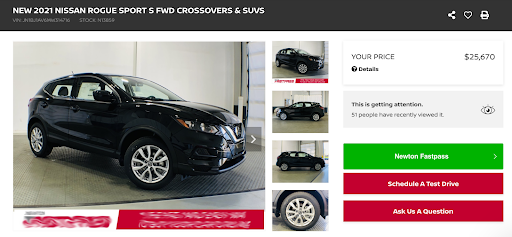Discover the true value of VDPs over SRPs
Where’s your campaign traffic going? Many automotive marketing teams aren’t asking this question of their vendors. Instead, they are asking “What was our Cost per Click?” Keep reading to find out why this is the wrong question to ask.
Most paid campaign clicks are landing on search results pages (SRPs), which shows website visitors multiple vehicles of the same type. For example, a person who searches “Nissan Rogue” on Google, sees, and clicks on an ad like this:
They land on an SRP, with 10 different Nissan Rogues. The assumption is that the person will scroll through their options, choose the trim, color, or price they like, then click to a VDP. Maybe then, they’ll navigate back to the SRP, choose a different trim or color, and click to yet another VDP. In other words, we're asking them to shop like they are on Amazon.
The reality is, dealership websites aren’t built like Amazon, and so shoppers are much more likely to get frustrated. Where they land first is important; it’s where they will either make decisions and contact you in some way, or it’s where they will quickly bounce off. This is especially the case on SRPs. The data across pretty much every dealership website shows that most visitors that land on an SRP are not going to make it to a VDP at all. In fact, less than a third of the traffic for any campaign that lands users on an SRP will lead to a visit to a VDP. This means that a significant amount of the campaign’s budget is being wasted driving people to the wrong places, where no engagement or post-click activity happens.
Engagement, Not Clicks
The reason that most marketing agencies aren’t analyzing performance once the user clicks on the website is because they aren’t looking for engagement; they are looking for clicks. Most campaigns are built upon this one metric: click-through rate. How many people are landing on the page you are sending them to by clicking your ad?
The problem with that kind of metric is that it equates a click with a “lead.” But we all know that clicks aren’t leads; they are opportunities. And for opportunities to turn to leads, there has to be engagement. Engagement goes beyond the initial click; it shows what the click interacted with after landing on the page. Take a look at SRPs and VDPs side-by-side:
There is one CTA on the SRP, which opens a Digital Retailing tool. However, on the VDP, there are two added CTAs, as well as photos to scroll through, and an entire page of details for the consumer to read and interact with. This creates a natural research process that isn’t based on color and price alone, and creates a multitud$$e of ways for the user to engage with the vehicle and potentially become a lead.
You might say “My SRPs have many CTAs and multiple photos of my vehicles.” If this is the case, that’s great! However, you still need to look at the engagement levels between your SRPs and your VDPs to understand how the user actually engages in your content. For most dealers, engagement rates on VDPs tend to be in the neighborhood of 10-12 times higher than on SRPs. That’s a huge difference! Engagement is what creates leads so you should be trying to drive the highest level of engagement.
If this is what you want, then why are you reading reports every month from your campaign vendors showing click-through rates and conversions that mean very little to your lead count or, ultimately, your bottom line?
Challenge the Status Quo
Let’s go back to that Nissan Rogue search. What if that search was targeted with a VDP-based campaign instead of an SRP-based campaign? This has several benefits:
It enables you to control exactly what Rogue you want to try and sell; instead of landing the consumer on all the Rogues on your lot, you can land them on the one Rogue that has been on your lot for over 100 days–the Rogue that needs eyes on it the most,
It allows you to control how much of your marketing budget is allocated to individual vehicles; this is a key tactic in reducing your marketing spend waste.
It allows you to improve and optimize your remarketing campaigns based on vehicles users have actually shown interest in, which improves the performance of intelligent marketing platforms like Google and Facebook.
It allows you to drive the vehicle exposure and engagement that convert opportunities into leads and leads into sales–on the vehicles that actually need the exposure!
This gives the customer not only what they are looking for, but it also gives them the chance to interact with the vehicle and increase your chances of selling it. You know this Rogue will sell eventually, but to decrease your days-on-lot, you must send traffic directly to it, instead of hoping and praying for consumers to choose it instead of the 10 other Rogues on the SRP page.
Remember: You have a very short period to keep the user’s attention, so you need to focus it where you need it and where the user wants it–the VDP of the specific vehicle they are looking for.
As dealer marketers, you are the ones who have to push back against vanity metrics to see the engagement and interactions of the clicks you are receiving from your campaigns. If you are seeing that landing on SRPs is not working to drive engagement and leads, then you have to change where those clicks are landing. You may have to challenge your vendors to change the way they are setting up your campaigns. Many vendors will be well-versed with reasons for landing on SRPs, but chances are, their reasons never consider the data.
These reasons most often make broad assumptions around user behavior; such as shoppers landing on SRPs and looking through 5 or 6 different units of their chosen model. The reality is that less than 30% of users landing on an SRP even look at 1 vehicle’s VDP. Less than 15% look at 2 or more vehicles’ VDP.
We see this same problem consistently across hundreds of dealership websites, and it leads to massive waste of your marketing spend. It is up to you to challenge the status quo and put your vendors to the test on finding the right metrics to measure campaign performance.
With VIN IQ, we think you’ll see that challenging the status quo will be well worth it.
3 Simple and Effective Action Steps for Today
Check the Behavior Flow report within Google Analytics and look at your campaign traffic’s actions.
Go to Behavior > Behavior Flow in GA.
Add a segment audience for campaigns (example below).
Be sure and know what your SRP and VDP urls look like (/inventory, /new-vehicles, etc) so you can follow your traffic.
Email your vendors and ask for a list of landing pages for your campaigns from each of them. This will help you investigate where your traffic is going, instead of just if they are clicking your ad campaigns.
Look more closely at your last reports from your vendors. Do they have conversions, like phone calls, lead forms, or chats, listed specifically for you? Or do they only provide the number of clicks, number of unlabeled conversions, etc?
For an automotive-centric approach, check out VIN IQ’s 60-day free trial for your dealership’s marketing analysis and sales recommendations.




